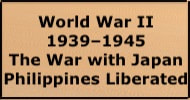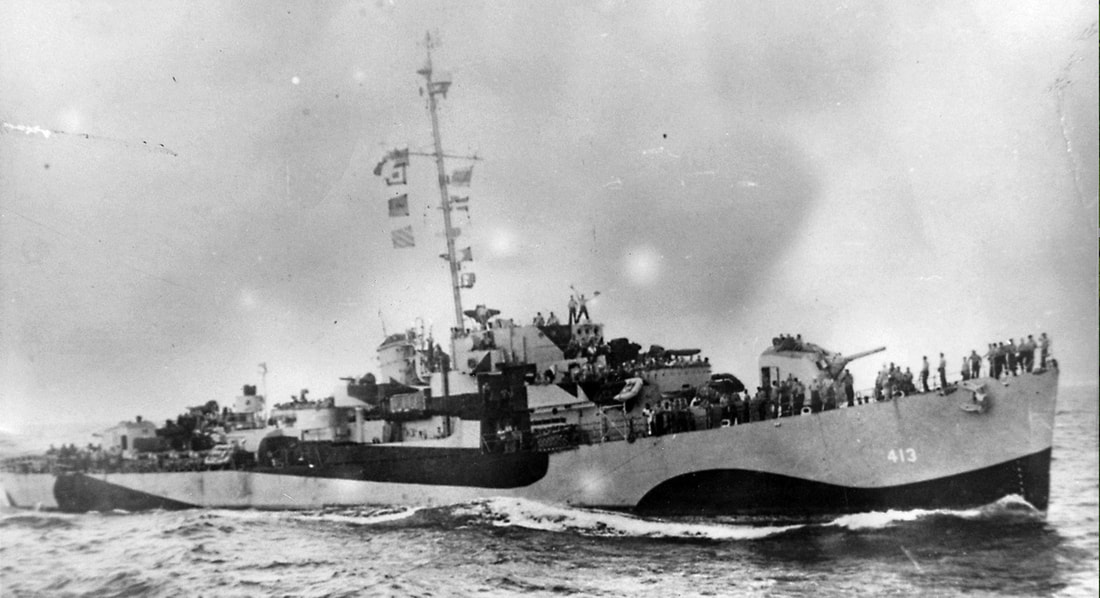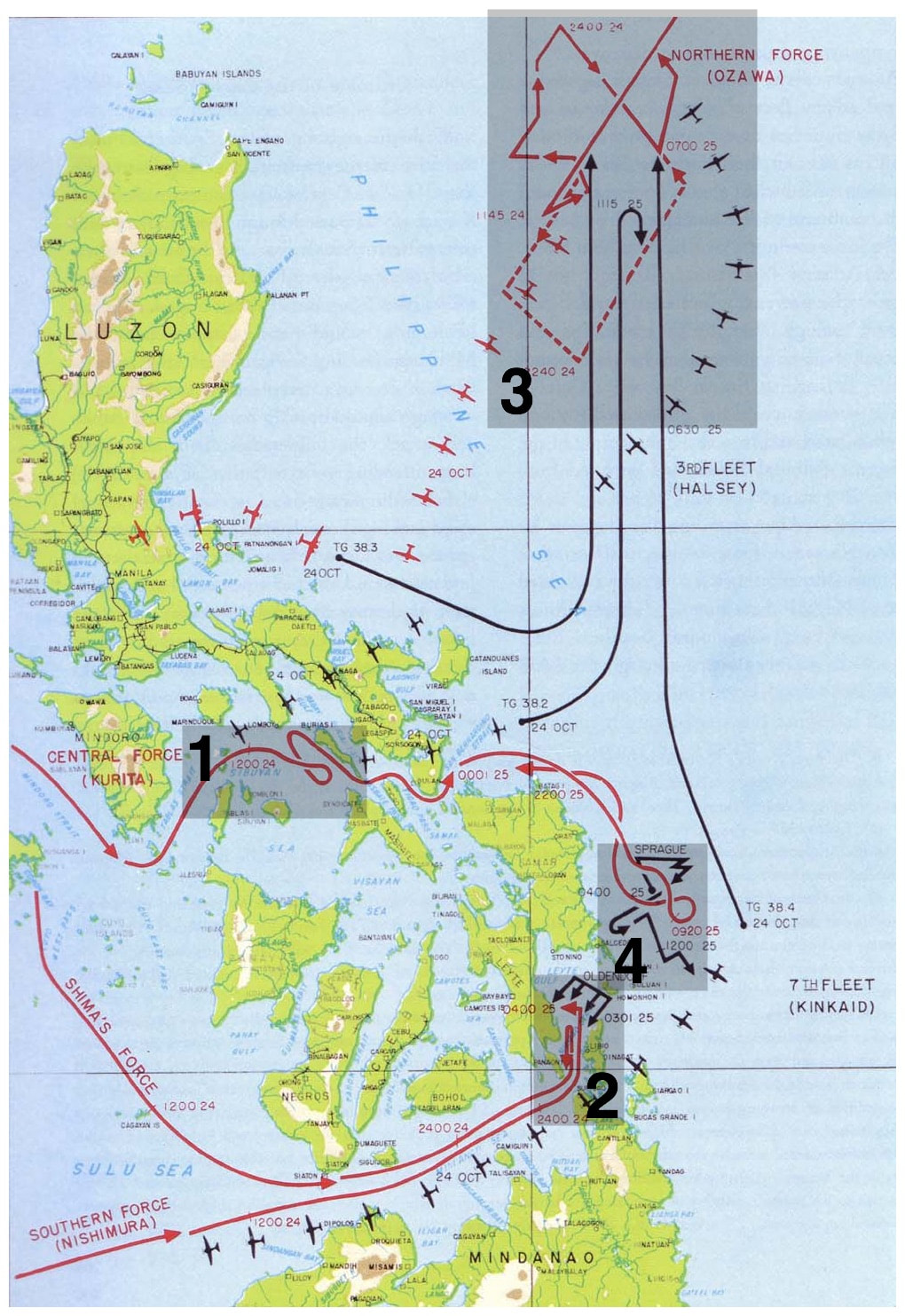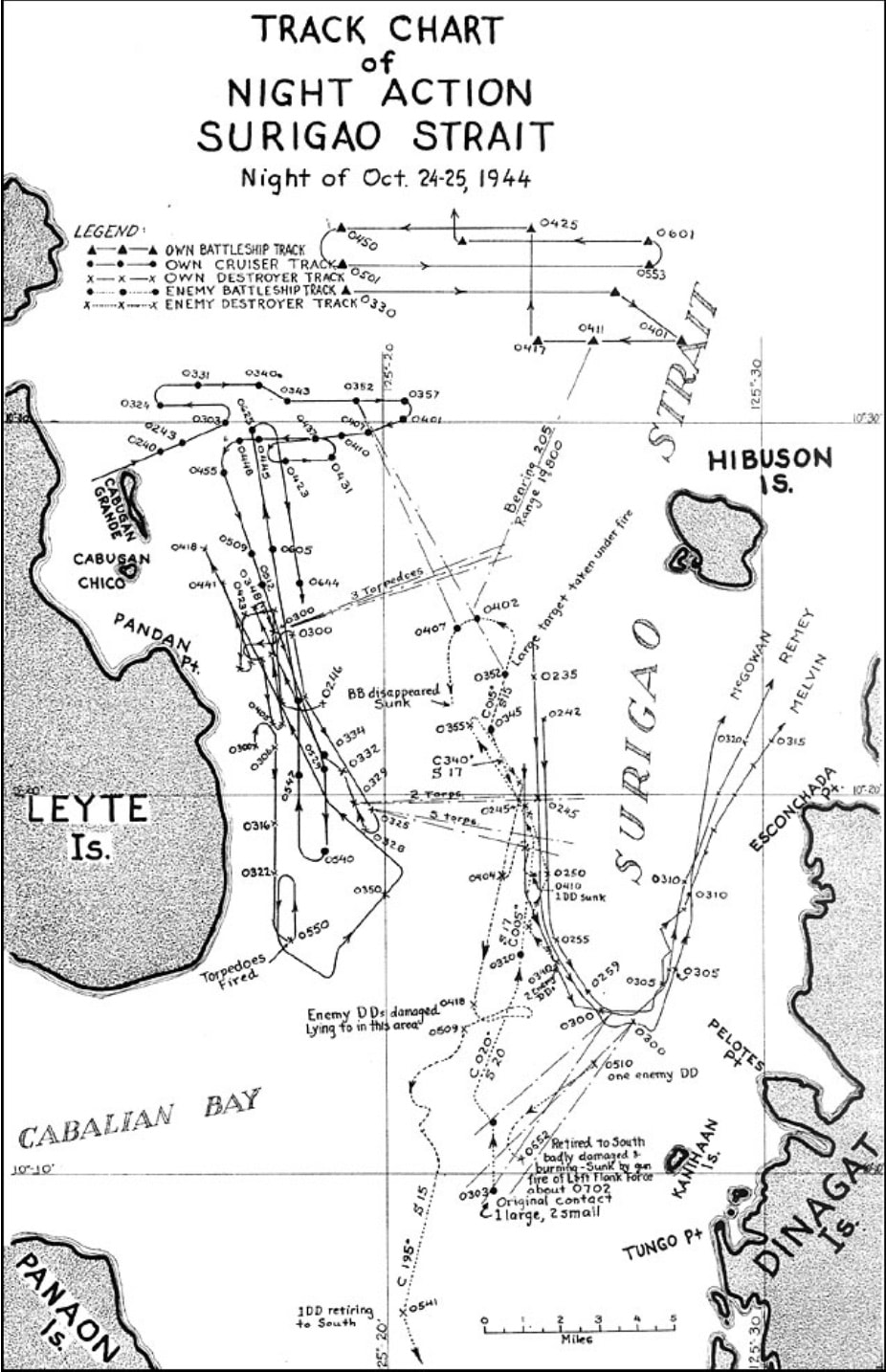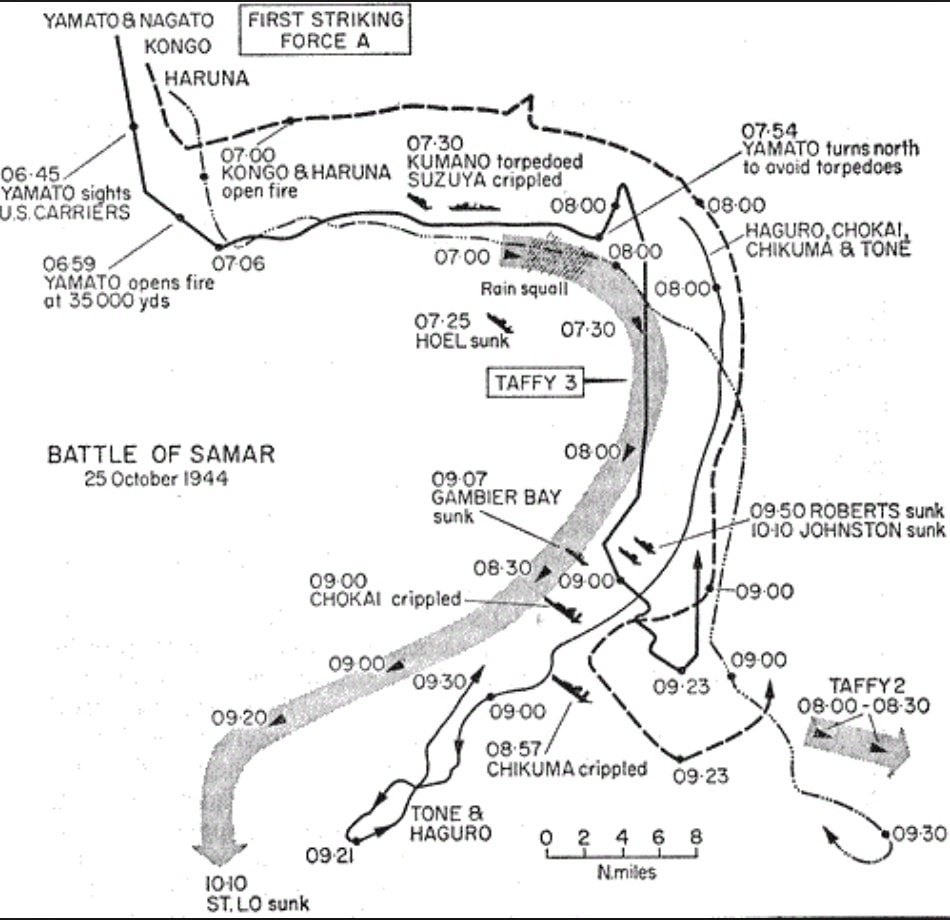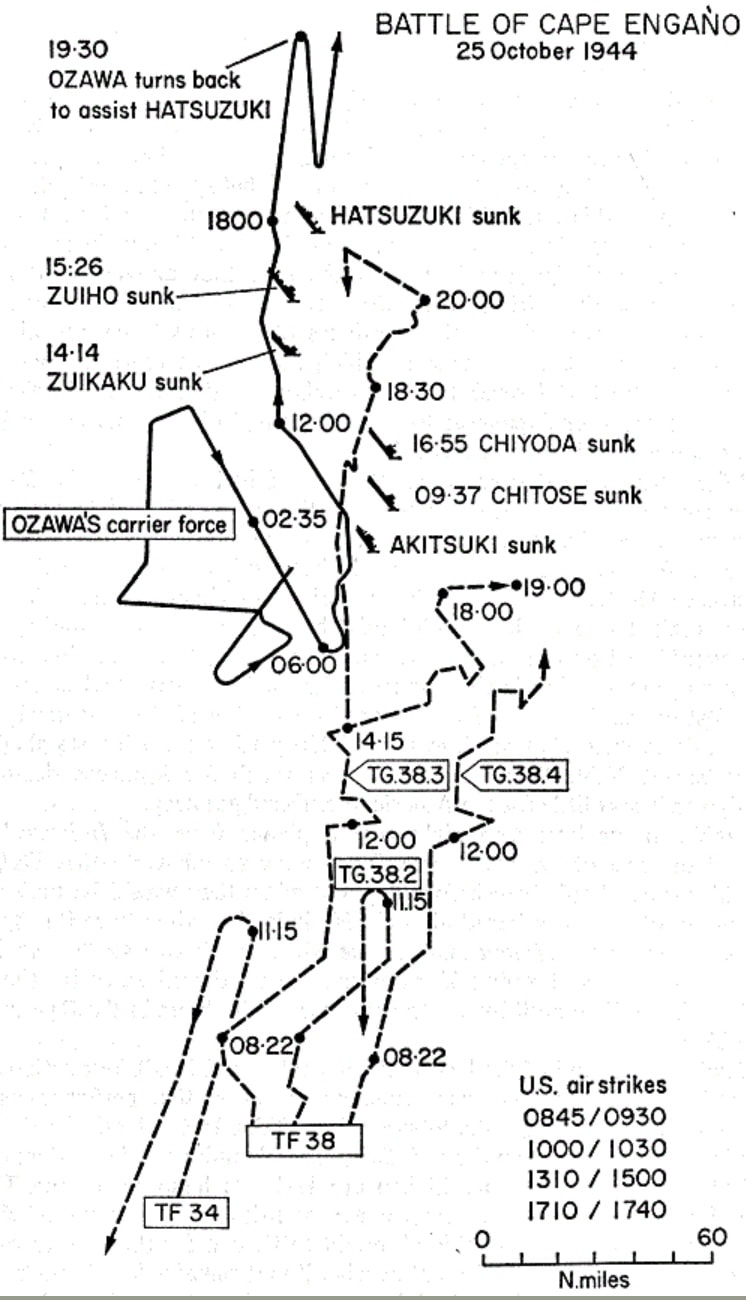bigpigeon.us webpage WWII Japan > Philippines Liberated > Battle of Leyte Gulf, © 2024 by Robert A. Christiansen, updated by RAC 23 Mar 2024.
After the 20 October 1944 US landing on Leyte's east coast, the Imperial Japanese Navy marshaled most of its remaining large warships. The resulting Battle of Leyte Gulf was a collection of naval engagements fought near Leyte and Samar for several days. The Battle of Leyte Gulf may have been the largest naval battle in history.
After the 20 October 1944 US landing on Leyte's east coast, the Imperial Japanese Navy marshaled most of its remaining large warships. The resulting Battle of Leyte Gulf was a collection of naval engagements fought near Leyte and Samar for several days. The Battle of Leyte Gulf may have been the largest naval battle in history.
Much of the remaining Japanese Navy was destroyed in the Battle of Leyte Gulf. The webpage Philippines Naval War touches on subsequent naval combat during the liberation of the Philippines.
The four army divisions that initially landed on Leyte were supported by two navy fleets:
Most of Halsey's Task Force 38 had just participated in the Air Battle of Formosa, from 12 to 16 October. Here they had destroyed much of the Japanese air power that would have hindered US forces in the subsequent amphibious landing at Leyte and naval battles near Leyte. However, Task Force 38 was no longer fully equipped for combat, a fact that influenced the pending battle.
In a final attempt to destroy American forces, the Imperial Japanese Navy assembled most of its remaining combat-ready warships into the four groups as shown in red on the following map.
Historians generally break the entire Battle of Leyte Gulf into four segments. I believe it is easier to understand by listing seven separate engagements. In the following bullet list, one bullet is Halsey's fateful decision to abandon protection of the Leyte Gulf area and pursue the Japanese Northern Decoy Force.
The four army divisions that initially landed on Leyte were supported by two navy fleets:
- Admiral Thomas Kincaid's 7th Fleet, permanently attached to General Douglas MacArthur's command and charged with supporting MacArthur's land operations. The 7th Fleet included three task groups of small escort carriers, Taffy 1, Taffy 2, and Taffy 3, and a bombardment force of old battleships, of whom several had been sunk at Pearl Harbor and then raised and repaired.
- Admiral William Halsey's Task Force 38 of the 3rd Fleet, overseen by Admiral Chester Nimitz in Hawaii. Task Force 38 consisted of five task groups of varying strengths. Each task group had one or more fast aircraft carriers, and the 3rd Fleet also included fast modern battleships. The 3rd Fleet arrived in the Philippines from operations off Formosa.
Most of Halsey's Task Force 38 had just participated in the Air Battle of Formosa, from 12 to 16 October. Here they had destroyed much of the Japanese air power that would have hindered US forces in the subsequent amphibious landing at Leyte and naval battles near Leyte. However, Task Force 38 was no longer fully equipped for combat, a fact that influenced the pending battle.
In a final attempt to destroy American forces, the Imperial Japanese Navy assembled most of its remaining combat-ready warships into the four groups as shown in red on the following map.
Historians generally break the entire Battle of Leyte Gulf into four segments. I believe it is easier to understand by listing seven separate engagements. In the following bullet list, one bullet is Halsey's fateful decision to abandon protection of the Leyte Gulf area and pursue the Japanese Northern Decoy Force.
|
|
|
When World War II began, Japan had the world's third largest navy, following England and the United States, and perhaps the best-trained navy. After the Battle of Leyte Gulf, the Japanese navy was no longer a cohesive force of any significance. The United States Navy would suffer serious losses after Leyte Gulf but they were mostly due to kamikaze pilots flying from land bases.
https://en.wikipedia.org/wiki/Battle_of_Leyte_Gulf provided the following list of warship losses during the Battle of Leyte Gulf. Actually the USS Eversole was sunk by a Japanese submarine several days later.
Allied losses[edit]
The United States lost 7 warships during the Battle of Leyte Gulf:
The Japanese lost 26 warships during the Battle of Leyte Gulf:
https://en.wikipedia.org/wiki/Battle_of_Leyte_Gulf provided the following list of warship losses during the Battle of Leyte Gulf. Actually the USS Eversole was sunk by a Japanese submarine several days later.
Allied losses[edit]
The United States lost 7 warships during the Battle of Leyte Gulf:
- One light aircraft carrier: USS Princeton
- Two escort carriers: USS Gambier Bay and USS St. Lo (the first major warship sunk by a kamikaze attack)
- Two destroyers: USS Hoel and USS Johnston
- Two destroyer escorts: USS Samuel B. Roberts and USS Eversole
- Four other American ships, along with HMAS Australia, were damaged.
The Japanese lost 26 warships during the Battle of Leyte Gulf:
- One fleet aircraft carrier: Zuikaku (flagship of the decoy Northern Forces).
- Three light aircraft carriers: Zuihō, Chiyoda, and Chitose.
- Three battleships: Musashi (former flagship of the Japanese Combined Fleet), Yamashiro (flagship of the Southern Force) and Fusō.
- Six heavy cruisers: Atago (flagship of the Center Force), Maya, Suzuya, Chokai, Chikuma, and Mogami.
- Four light cruisers: Noshiro, Abukuma, Tama, and Kinu.
- Nine destroyers: Nowaki, Hayashimo, Yamagumo, Asagumo, Michishio, Akizuki, Hatsuzuki, Wakaba, and Uranami.
Sources for Big Pigeon's Philippines Liberated > Battle of Leyte Gulf webpage:
Pottawattamie Area WWII Dead - Philippines Liberated > Battle of Leyte Gulf:
† Bales, Paul Edgar, SN 859-09-72, US Navy, Adair Co.
- The webpage header photo, USS Samuel B. Roberts, is courtesy of www.navsource.org.
- The Battle of Leyte Gulf, October 1944 map - https://en.wikipedia.org/wiki/Philippines_Campaign_(1944–1945)#/media/File:Leyte_map_annotated.jpg
- The Battle off Samar map is courtesy of saltofamerica.com.
- The Battle off Cape Engano map is courtesy of saltofamerica.com.
- https://www.ibiblio.org/hyperwar/USN/rep/Leyte/BatExp/Leyte-BE-78.1.html is a good on-line overview.
- https://warfarehistorynetwork.com/daily/wwii/clash-at-surigao-strait-the-last-battle-line/ details the Battle of Suriago Strait.
Pottawattamie Area WWII Dead - Philippines Liberated > Battle of Leyte Gulf:
- Taken from the bigpigeon.us WWII Dead module.
† Bales, Paul Edgar, SN 859-09-72, US Navy, Adair Co.
- Destroyer USS Hoel (DD-533), Task Unit 77.4.3 (aka Taffy 3), Seventh Fleet; KIA 25 Oct 1944 off Samar, Philippines; the Hoel, Johnston, & Samuel B. Roberts were all sunk after their tenacious attack on a vastly-superior Japanese force; Battle off Samar - Philippines Liberated > Battle of Leyte Gulf; BNR.
- Escort Carrier USS Gambier Bay (CVE-73), Task Unit 77.4.3 (aka Taffy 3), Seventh Fleet; KIA 25 Oct 1944 off Samar, Philippines; Gambier Bay sunk by Japanese shells, ~147 dead; Battle off Samar - Philippines Liberated > Battle of Leyte Gulf; BNR.
- Escort Carrier USS St. Lo (CVE-63), Task Unit 77.4.3 (aka Taffy 3), Seventh Fleet; KIA 25 Oct 1944 off Samar, Philippines; St. Lo sunk by kamikaze, ~ 143 dead; Battle off Samar - Philippines Liberated > Battle of Leyte Gulf; BNR.
